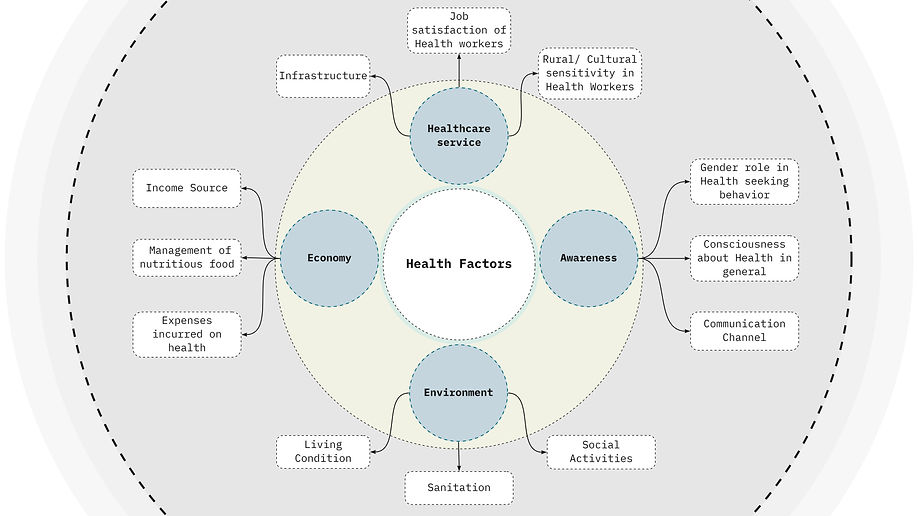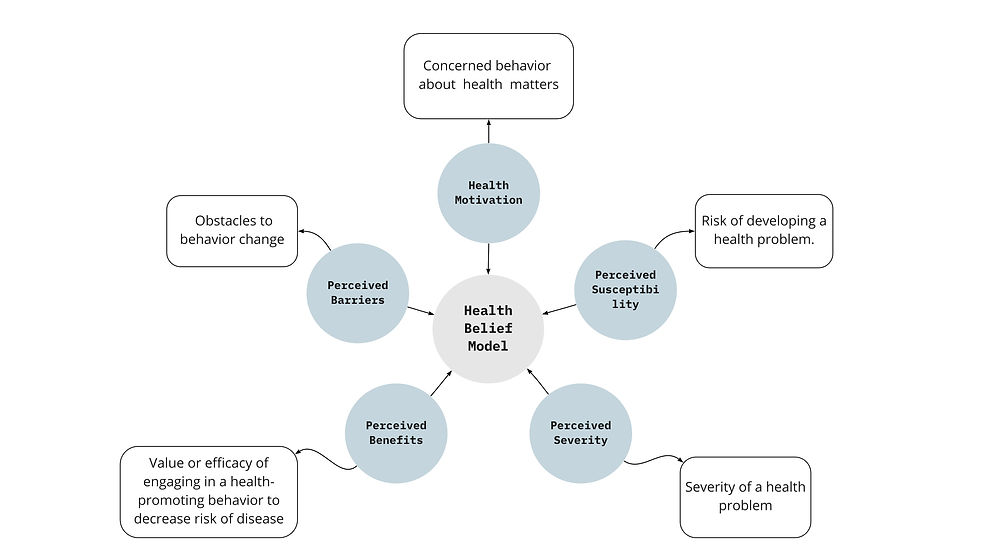
Challenges and Design Opportunities
for Rural Healthcare
in collaboration with

The OBJECTIVE of this project is to research rural healthcare sector since healthcare is the central pillar of the rural society and economy hence it is needed to be understood at behavioral level to get deep insights which helps to establish a robust and empathetic healthcare system.
About Prabuddh gram initiative
An integrated village development scheme, envisaged to be implemented through an inter-ministerial collaborative framework.
This scheme covers 9 thematic areas
Road Planning
Smart Transport Systems
Village Architecture
Waste Management
Healthcare
Sustainable Water & Energy Utilization
Education
Agriculture
Local Art/ Craft and Culture


Project work flow
Research methodology
Duration of study conducted on site : 3 Days
This study employed multiple research tools on the basis of requirement and to aid the researcher in digging deeper into the underlying causes/problems. The tools used were :
Observational Method
Researchers observe participant’s ongoing behavior in a natural situation. The researcher will have varying levels of participation in the study. Sub types explored were Controlled Observation, Participant Observation.
Observe Think & Wonder
A critical-viewing strategy to help us in analysis of visual media captured as part of research. Slowing down the thinking process and deep observation with continued probing before drawing conclusions.
Artifact Analysis
A process to better understand how prescribed medicine is being used by its users and the culture in which it typically exists. It also serves as an opportunity for us to systematically generate insights and inspiration for future product/service designs.
Semi-Structured Interviews
This method opted to draw out more specific inferences by asking repeated follow up questions.Leading with open-ended questions which are questions that can't be answered with a simple "yes" or "no."
Group Discussion
To gain an in-depth understanding of social issues and to obtain data from a purposely selected group of individuals.
Sample size: 18 Males and 15 Females.
Age group between 30 to 60.
Secondary Research
This method opted to draw out more specific inferences by asking repeated follow up questions.Leading with open-ended questions which are questions that can't be answered with a simple "yes" or "no."
Pilot Study
A few assumptions and hypotheses were drawn according to this secondary research. A pilot study was then conducted in a nearby village to check if these assumptions were right or wrong and to further understand the ground reality in rural areas.
Summarizing secondary research

Pilot Study



Visiting a nearby village to test the initial hypothesis and get a better understanding of the overall context.





FIELD VISIT
After the Pilot study we devised Research tools for our primary research. We went to Bhiura Village for 3 days to understand the context of the village, it's setting, social structure and deeper understanding of issues.






-
"Draw/ Sketch what you perceive about Cleanliness and Hygiene" this could be anything they like.
-
Time limit 1 Hour
-
Material to be shared between the participants. This was purposely done to observe participation, collectiveness and positive attitude.
-
After completion of drawings, each and every kid was asked to explain why they drew what they drew, followed by semi structured questionings.







Health Belief Model (HBM)
Analysis

INSIGHTS GENERATED AND PROPOSED DESIGN DIRECTION
Insight
People place higher subjective value and associate a sense of ownership with medicines & prescriptions received from private healthcare since they had paid a premium for the treatment resulting devaluing of prescription and medicines received from government healthcare facility as they cost only 1 rupee.
Further Study
Digital prescription as data recording
Prescription as Health Seeking behavior mapping tool.
Opportunity Area
There is need to instigate a sense of ownership and value addition towards government provided prescription and medicines.
Design direction

Prescription Re-Design


Insight
Awareness programs fail to produce the desired optimal behavior because they are not propagated through proper channels and target specific age, gender and community.
Further Study
Opportunity Area
There is an opportunity to design communication strategies defined by it's target audience and propagates through proper channels leaving no person/ kid behind.
Research on communication channels in rural India.
Research collaboration with dietitian and chefs to design recipes.


Nutrition Awareness-cum-Recipe Book
Making kids aware with simple grounded stories/ comics
Design direction
Include teenagers as the Health Care Cadets (HCC)

Insight
Due to no tangible Healthcare service touch points in the village tend to avoid consulting with ASHA/ ANM at their residence for Health related consultations because social stigma and shyness. This results in infrequent visit to Healthcare facilities and people become more susceptible to illnesses.
Rural Healthcare service on ground does not functions as per the given guidelines(2012) due to varying context of Rural areas in India, One size fits all model fails to create the desired impact and foster positive optimal behavior in both staff & patients.
Opportunity Area
There is an opportunity to build an infrastructure which caters as a Sub Center-cum-Multi Utility Space, in order to externally trigger villagers to visit this place frequently. Gradually anchoring the need to seek Healthcare services via designed awareness programs.
There is a need to re look and revamp the whole Rural Healthcare Model after detailed service and design audit. Government healthcare provider should act as a leader in the society.
Design direction
Extending reach of Healthcare facilities touchpoint

Insight
First-time mothers when compared to experienced mothers tend to visit CHC more often for health checkups (Antenatal Checkups) as they perceive it as an explorative and recreational activity.
Further Study
Opportunity Area
There is a potential to tap into the Health Seeking Behavior of the mothers to spread more awareness and foster their trust and ownership towards state medical Healthcare facilities for
Types of activities they involve into at home during pregnancy period.
Impact assessment of their visit to Doctors and interaction with ASHA and ANM
Design direction
Exercise and well being sessions for pregnant women at CHC. It would encourage interaction between them and help internalizing the health facility within them.

Insight
Medical staff tend to bring their kids at CHC/ workplace due to the absence of any caretaker at home. This can potentially expose kids to various communicable diseases and also disturbs other doctors and patients.
Opportunity Area
There is a need for a facility which could assure staff mothers of their kids well being and enable them to render their work with full efficiency.
Further Study
Their is a need to study the societal acceptance of day care facilities.
Design direction
Day care facilities for staff and patients at CHC

Insight
People tend to avoid spaces where they find it hard to navigate or create a mental map of the space. CHC is not navigation friendly due to lack of proper directional signage and staffs who could guide which make people anxious.
Opportunity Area
There is a need to equip health center with appropriate and easy to recognize signage boards which could ease and enhance the experience of visitors.
Further Study
Study of Rural Hospital and it's psychological impacts
Functional Literacy and it's behavioral impacts.
Design direction
Improved Way finding system

